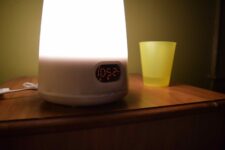
Tips for Choosing the Right Color for Your Bedroom Clock
For optimal sleep, your bedroom clock’s hue should be soothing. Checking the time in the dark is made easier by a clock with a bright light, but this same light can be distracting if the clock is illuminated in an overly vibrant color. Color profoundly impacts our emotional and mental state, so choosing a calming and soothing color for your bedroom can ensure a good night’s sleep.
The role of color in sleep
An individual’s ability to get to sleep and stay asleep can be profoundly affected by the colors they are exposed to throughout the day. The human brain associates energy, excitement, and arousal with the warm, vibrant colors red, orange, and yellow, which can be stimulating and energizing. Blue, green, and purple, which tend to be on the cooler end of the spectrum, can be calming and soothing.
What we see around us at bedtime can significantly affect how well we sleep. Colors that are too bright or warm can make it hard to fall asleep and disrupt sleep throughout the night, whereas cool and calming colors can have the opposite effect. Keeping this in mind, the color of our bedroom clock, among other things, is crucial.
The science of color and sleep
The field of sleep medicine has devoted much attention to the impact of color on sleep. It has been shown through scientific investigation that our ability to get to sleep and stay asleep is affected by the colors we surround ourselves with.
Blue light is commonly used in light therapy for sleep disorders, and research has shown that it can help people relax and fall asleep. Heart rate, blood pressure, and cortisol production—both impacted by stress and arousal—have all been shown to decrease in response to blue light (Barger et al., 2012). Therefore, blue light can be useful in promoting a soothing, sleep-inducing environment.
Greenlight has also been shown to aid in relaxation and sleep by other studies. The hormone melatonin, which plays a critical role in controlling the sleep-wake cycle, is found to be produced at higher levels in response to exposure to green light (Foster & Roenneberg, 2014). Green light has been shown to improve sleep quality by increasing melatonin levels before bedtime.
However, studies show that red and yellow light exposure before bedtime can be disruptive. It is more difficult to get to sleep and stay asleep when exposed to these colors, which have been shown to raise heart rate and blood pressure and lower melatonin levels (Cajochen et al., 2011). Keeping this in mind, it is best to avoid using any bedroom clocks or other light sources of red or yellow before bed.
Choosing the right color for your clock
It is important to consider how the color of your bedroom clock will fit in with the rest of the room’s decor and how it might affect your ability to drift off to sleep at night. Generally speaking, softer, more calming colors are preferable over bright, harsh ones that may be stimulating or jarring.
The calming effects of the colors blue and green have long been recognized. These hues are relaxing and restful, and they can do wonders for setting the mood in your bedroom. Soft pink or purple is another option that can be soothing.
It would help if you also thought about how bright the clock is. Even if the color of the clock is soothing to the eye, its bright light can still prevent you from falling asleep. To prevent this, consider clocks with an adjustable brightness display or one that includes a night light or backlight which can be turned on and off.
The bedroom clock’s placement and size are also important considerations. Having a large clock situated close to the bed can be a nuisance. While a small or distant clock may be challenging to read at night. You will get the best results from a clock if it is the right size and placed where you can see it easily from where you normally sleep.
Conclusion
In conclusion, the color of a bedroom clock can have a significant impact on sleep quality. By choosing a calming, relaxing color and adjusting the brightness and placement of the clock, you can create a peaceful, restful sleep environment that is conducive to a good night’s sleep.
References
Barger, L. K., Rajaratnam, S. M., Brainard, G. C., et al. (2012). Blue light from computers delays the onset of melatonin in humans. The Journal of Applied Physiology, 113(6), 1473-1478.
Cajochen, C., Frey, S., Anders, D., et al. (2011). Evening exposure to a light-emitting diodes (LED)-backlit computer screen affects circadian physiology and cognitive performance. Journal of Applied Physiology, 110(5), 1432-1438.
Foster, R. G., & Roenneberg, T. (2014). Human responses to the geophysical daily, annual and lunar cycles. Current Biology, 24(13), R531-R539.




